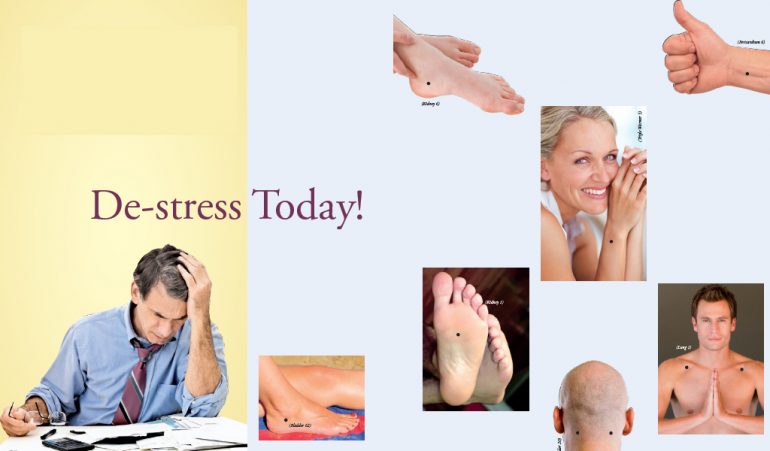When you are under stress, your body is not able to work at its maximum efficiency to keep you healthy. That is why stress is at the root of so many different and more serious diseases. With our hectic lifestyles and busy schedules, it’s hard not to be under stress these days! Even children, with school, homework, after school activities, and peer pressure, feel stressed out at times.
To help relieve the stress in your family’s life and enable you to be more at peace, we’ve found these remedies to be useful.
ACUPRESSURE
Acupressure is especially beneficial for feelings of stress and inability to cope because it is such a powerful way to relax and re-balance your body. The following points will assist you in remaining centered. Each point can be done individually, or they all can be done as a group. Do them on a daily basis and hold each point for about two minutes. Help your children to do the points at first.
2nd Outer Ankle Point (Bladder 62)
In the depression under the outside ankle bone.
Benefits:
Useful in relieving nervousness and tension headaches.
Inside Ankle Point(Kidney 6)
In the depression located just below the inner ankle bone.
Benefits:
Useful for insomnia and headaches.
Caution:
Do not use on pregnant women.
Bottom of Foot Point (Kidney 1)
One-third of the way from the toes to the heel, on the bottom of the foot.
Benefits:
Useful for centering and energy balance.
Caution:
Do not use on pregnant women.
Back of Arm Point (Triple Warmer 5)
About two inches from the back of the wrist, between the two bones of the forearm.
Benefits:
Useful for relieving tension, depression, headache, or nervousness.
Back of Neck Point (Gallbladder 20)
Just below the occipital bone and two inches from the midline of the neck.
Benefits:
This helps in lowering fright and aggression.
Front of Arm Point (Pericardium 6)
On the inside of the arm, about two inches up from the wrist, between the two bones.
Benefits:
Useful for relieving depression, dizziness, nausea, nervousness, and sleepiness.
Caution:
Do not use on pregnant women.
Front Shoulder Point (Lung 1)
On the front of the chest wall, one inch below the clavicle and six inches out from the sternum.
Benefits:
Useful for letting go of frustration, fear, or anger.
AROMATHERAPY
Any of these oils can be used to help you calm down and feel more relaxed:
- Basil is good in the workplace, as it helps with environmental and mental stress.
- Chamomile is calming when you feel stressed from the environment, loud noises, or uncomfortable arrangements. It is also used when you feel physically stressed, as from a long commute or from working out too much.
- Geranium is excellent for combating all kinds of stress.
- Lavender is good for physical or mental stress, or for chemical stress, as when you’ve drunk too much coffee or eaten too much junk food.
- Rose is especially good for emotional stress.
AYURVEDA
Ojas is an Ayurvedic word that refers to our life energy. Translated, it means “vigor.” Stress greatly reduces ojas,which then weakens the immune system. When ojas is low, disease can follow.
To replenish ojas, follow the routine for your dosha, or mind/body type: Vata, Pitta, or Kapha. Some foods, such as milk and ghee, are especially good for increasing ojas. Meditation is the best thing you can do to alleviate stress and thereby increase ojas.
Vata tea is calming and soothes the nerves. It is delicious with a little bit of brown sugar. There are several companies that make the Vata blend of herbs that go into the tea; or you can make it yourself. The traditional blend consists of: licorice, ginger, cardamom and cinnamon.
If you’re feeling stressed because you are angry, Pitta tea will help “cool you off.” Peppermint, or any other mint blend, will also do the trick!
BACH FLOWERS
Bach Flowers are extremely powerful in fighting and even preventing stress. Most stress has an emotional basis, and Bach Flower Remedies are excellent for getting to that emotion.
- Aspen should be taken when you feel a vague foreboding, when your fear is from an unknown origin.
- Impatiens helps to relieve mental and physical tension. It should be used when you feel irritable or impatient.
- Mimulus soothes nerves. It is best used when you have a fear of something known.
- Red Chestnut is helpful when you fear for someone else’s health or safety.
- Rock Rose alleviates extreme fear and panic attacks.
- Rock Water helps you to relax when you overwork or are hard on yourself.
- Vervain helps to relieve the stress and tension you feel from over-enthusiasm.
- White Chestnut is best for getting rid of worry and unwanted thoughts.
COLOR THERAPY
Specific energies respond significantly to a variety of stress symptoms. Stress goes with you wherever you go, and your environment is very important in how stressed you feel. The color of your clothes and the colors in your home and workplace have a strong effect on your mood and tension level. Wear and surround yourself with colors that make you feel more at peace. Placing coolcolored light bulbs in your lamp will also bring down your stress level.
- Blue is calming and helps to relieve anxiety.
- Orange is a mood lifter and will help you to overcome fatigue or depression.
- Turquoise alleviates stress and tension.
HERBS
The following herbs can help reduce the stress level in your life:
- Melissa is calming and is best used in combination with passionflower.
- Passionflower is calming and helps to relieve anxiety.
- Skullcap reduces stress and relieves anxiety.
- Valerian reduces stress but also can make you sleepy.
MEDITATION
Meditation is the single most important way that you can reduce stress in your life. A regular meditation routine of twenty minutes in the morning upon arising and twenty minutes before dinner will change your entire body chemistry and sense of balance. If this does not fit in with your lifestyle, five-minute meditation throughout the day also will give you great benefits.
There are many different types of meditation practices, so experiment and find the one that works best for you, or mix it up depending on how you feel that day. It is valuable to change your meditation style each day to keep your meditation practice fresh and interesting. Frequent changes in style will also help to keep your child interested. You may wish to encourage your child to meditate by practicing with him or her until it becomes a habit. Children often enjoy soft music in the background when they meditate.
Meditation is a time to let go of your daily tensions and anxieties, a time to let your mind and body relax and just be. It is also a time to gain insight into your inner resources.







